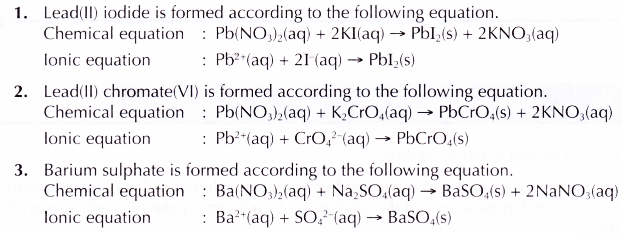Describe the preparation of soluble and insoluble salts
How do you prepare a soluble salt?
Preparing soluble salts of ammonium, sodium and potassium:
- Ammonium salts, sodium salts and potassium salts are prepared by a titration method based on neutralisation reactions between acids and alkalis.
- Ammonium salts are obtained by neutralising ammonia solution using dilute acids.
Example:

- Sodium salts are prepared by neutralising sodium hydroxide solution with dilute acids.
Example:

- Potassium salts are produced when dilute acids neutralise potassium hydroxide solution.
Example:

- This method involves four stages:
- A titration is carried out to determine the exact volume of an acid needed to neutralise a fixed volume of an alkali solution with the help of an indicator.
- This volume of acid is then added straight to the same volume of alkali solution without any indicator to obtain a pure salt solution.
- Crystallisation is carried out to obtain crystals of the salt.
- Recrystallisation is done to obtain pure crystals of the salt.
People also ask
- Classification of Salts
- General Properties of Salts
- Uses of different salts in daily life
- Preparation of Salts
- Qualitative Analysis of Salts
- Action of Heat on Salts
- Test for Cations and Anions in Aqueous Solutions
- Constructing ionic equations using the continuous variation method
- What is stoichiometry and why is it used in chemistry?
Preparing soluble salts other than ammonium, sodium and potassium salts
- Soluble salts which are not ammonium, sodium and potassium salts can be prepared by reacting dilute acids with insoluble metals, bases or carbonates.
- Acid + metal → salt + hydrogen
- Acid + metal oxide → salt + water
- Acid + metal hydroxide → salt + water
- Acid + metal carbonate → salt + water + carbon dioxide
- For example, magnesium sulphate is obtained from any one of the following reactions.

- For the reaction between dilute acids and metals:
(a) avoid using nitric acid because it can act as an oxidising agent, giving complicated mixture of products.
(b) unreactive metals such as copper and silver do not react with dilute acids.
(c) never attempt to react acids with very reactive metals such as sodium and potassium as the reactions are very vigorous and may explode. - The method used involves the following steps.
- Excess solid (metal, metal oxide, metal hydroxide or metal carbonate) is added, with stirring, into a fixed volume of hot dilute acid. The unreacted solid is removed by filtration.
- The filtrate is evaporated to produce a saturated salt solution.
- The hot saturated salt solution is cooled for crystallisation to occur.
- The crystals formed are filtered out, washed and dried.
- Recrystallisation is carried out to obtain pure crystals of the salt.
How do you prepare an insoluble salt?
Preparing insoluble salts:
- An insoluble salt can be prepared by a precipitation method through a double decomposition reaction.
- In this method two aqueous solutions of two different soluble salts are mixed together to form the insoluble salt. The insoluble salt is formed as a precipitate and can be obtained by filtration.
- (a) The first solution must have a soluble salt which contains the cation of the insoluble salt.
(b) The second solution must have a soluble salt which contains the anion of the insoluble salt.
Preparing insoluble salts examples
1. Lead(II) sulphate is prepared as follows.
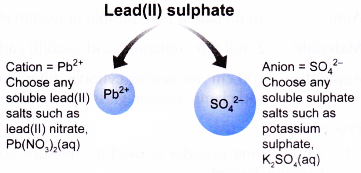
When the two salt solutions are mixed, a white precipitate of lead(II) sulphate is formed.
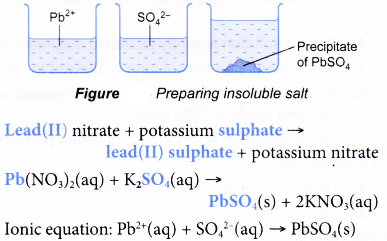
2. Copper(II) carbonate is prepared as follows.
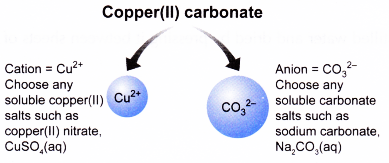
When the two salt solutions are mixed, a green precipitate of copper(II) carbonate is formed.
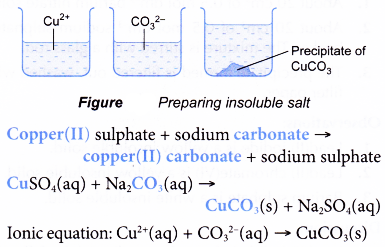
Physical characteristics of crystals
- Photograph shows a piece of copper(II) sulphate crystal.
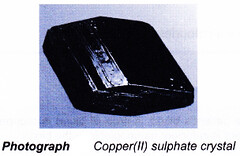
- The crystal has the following physical characteristics.
(a) Fixed geometrical shape
(b) Flat surfaces, straight edges and sharp corners
(c) Fixed angle between two adjacent surfaces - The characteristics can be explained as follows.
(a) The particles in a crystal are arranged in an orderly manner, closely-packed, in contact and at fixed positions.
(b) The orderly arrangement is extended repeatedly throughout the three-dimensional crystal lattice to give the overall shape of the crystal and also the characteristics of 2(b) and 2(c).
(c) The pattern of orderly arrangement of the particles is not the same in crystals of different substances. This gives rise to different geometrical shapes of crystals. Figure shows two different patterns of arrangements that give rise to cubic and pyramid shapes.
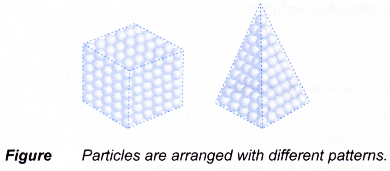
Preparing Soluble Salts Experiment 1
Aim: To prepare a pure sample of sodium chloride by mixing an acid with an alkali (titration method).
Materials: 2 mol dm-3 hydrochloric acid, 2 mol dm-3 sodium hydroxide solution, phenolphthalein and filter paper.
Apparatus: 25 cm3 pipette, 50 cm3 burette, 250 cm3 conical flasks, filter funnel, evaporating dish, Bunsen burner, tripod stand, retort stand and clamp, beaker, glass rod, white tile and wire gauze.
Procedure:
A. To determine the volume of hydrochloric acid needed to neutralise 25 cm3 of sodium hydroxide solution
- A clean pipette is used to obtain 25 cm3 of 2 mol dm-3 sodium hydroxide solution. The solution is transferred into a conical flask as shown in Figure.
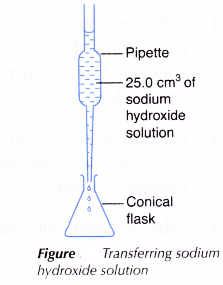
- 2 to 3 drops of phenolphthalein are added to the alkali solution.
- A clean burette is filled with 2 mol dm-3 hydrochloric acid. The initial burette reading is recorded.
- The hydrochloric acid is added slowly, with shaking, from the burette into the conical flask.
- The addition of hydrochloric acid is continued until the indicator just changes colour from pink to colourless. The final burette reading is recorded.
- Based on the burette readings, the volume of hydrochloric acid required to neutralise 25 cm3 of sodium hydroxide is calculated.
Volume of HCl needed to neutralise 25 cm3 of NaOH
= (final burette reading) – (initial burette reading)
= V cm3
B. To obtain a pure salt solution by a neutralisation reaction
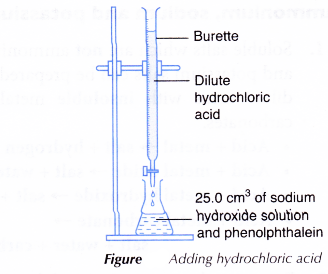
- 25 cm3 of the sodium hydroxide solution is pipetted into a clean conical flask. No indicator is added.
- From a burette, V cm3 of the hydrochloric acid is added, with shaking, to the alkali in the conical flask. The conical flask contains a pure salt solution now.
C. To obtain crystals of the salt by crystallisation
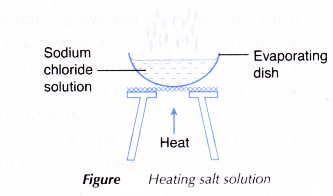
- The salt solution is poured into an evaporating dish.
- The salt solution is gently heated to evaporate the solution to one-third of its original volume, producing a saturated solution.
- The hot saturated salt solution is allowed to cool for crystallisation to take place.
- The crystals formed are filtered out, washed with a little cold distilled water and dried between sheets of filter paper.
D. To obtain pure salt crystals by recrystallisation

- The crystals obtained in section C are placed in a beaker.
- Distilled water is added to just cover the crystals. The mixture is gently heated while stirring with a glass rod. More distilled water is added a little at a time until all the crystals are dissolved.
- The solution is filtered to remove impurities. The filtrate is collected in an evaporating dish.
- The solution is evaporated to one-third of its original volume to obtain a saturated salt solution.
- The hot saturated salt solution is allowed to cool for crystallisation to take place.
- The crystals formed are filtered out, washed with a little cold distilled water and dried between sheets of filter paper.
Observations:
- The phenolphthalein indicator changes colour from pink to colourless.
- The salt crystals obtained are white solids.
Discussion:
- Hydrochloric acid neutralises the sodium hydroxide solution according to the following equation.
HCl(aq) + NaOH(aq) → NaCl(aq) + H2O(l) - Phenolphthalein indicator is used to determine the end point of the titration, that is, to determine the volume of hydrochloric acid required to completely neutralise 25 cm3 of sodium hydroxide solution.
- Impure soluble salts can be purified by using recrystallisation. These salts must be more soluble in hot water than in cold water so that more crystals are formed when the hot saturated salt solutions are cooled.
- Recrystallisation can be repeated many times to obtain salt crystals which are very pure.
Conclusion:
Sodium chloride is a soluble salt. It is best prepared by a titration method using a neutralisation reaction between an acid and an alkali.
Preparing Soluble Salts Experiment 2
Aim: To prepare a pure sample of copper(II) nitrate by mixing an acid with a metal oxide.
Materials: 2 mol dm-3 nitric acid, copper(II) oxide and filter paper.
Apparatus: 100 cm3 measuring cylinder, filter funnel, evaporating dish, Bunsen burner, tripod stand, retort stand and clamp, beaker, glass rod, spatula and wire gauze.
Procedure:
A. To obtain crystals of copper(II) nitrate
- A measuring cylinder is used to measure 50 cm3 of 2 mol dm-3 nitric acid into a beaker. The acid is carefully heated.
- A spatula is used to add copper(II) oxide powder bit by bit with stirring to the hot acid until some of it no longer dissolves.
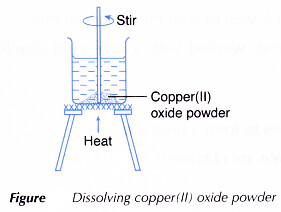
- The unreacted copper(II) oxide powder is removed by filtration. The filtrate is poured into an evaporating dish.
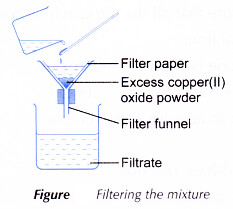
- The salt solution is gently heated to evaporate the solution to one-third of its original volume to obtain a saturated solution.

- The hot saturated salt solution is allowed to cool for crystallisation to take place.
- The crystals formed are filtered out, washed with a little cold distilled water and dried by pressing the crystals oo between sheets of filter paper.

B. To obtain pure copper(II) nitrate crystals by recrystallisation
- The crystals obtained in section A are placed in a beaker.
- Distilled water is added to just cover the crystals. The mixture is gently heated while stirring with a glass rod. More distilled water is added a little at a time until all the crystals are dissolved.
- The solution is filtered to remove impurities. The filtrate is collected in an evaporating dish.
- The solution is evaporated to obtain a saturated salt solution.
- The hot saturated salt solution is allowed to cool for crystals to form.
- The crystals formed are filtered out, washed with a little cold distilled water and dried by pressing them between sheets of filter paper.
Observations:
- The black copper(II) oxide dissolves to form a blue solution.
- Blue crystals of the copper(II) nitrate are obtained.
Discussion:
- Copper(II) oxide is a base and it neutralises the nitric acid according to the following equation.
CuO(s) + 2HNO3(aq) → Cu(NO3)2(aq) + H2O(l) - Excess copper(II) oxide is used to ensure that all the nitric acid is completely reacted.
- The acid is heated to speed up the reaction.
- Another base to replace copper(II) oxide is copper(II) hydroxide.
Cu(OH)2(s) + 2HNO3(aq) → Cu(NO3)2(aq) + 2H2O(l) - The copper(II) ion causes the solution to acquire a blue colour.
Conclusion:
A copper(II) salt can be prepared by an acid-base reaction.
Preparing Soluble Salts Experiment 3
Aim: To prepare a pure sample of zinc sulphate by mixing an acid with a metal.
Materials: 2 mol dm-3 sulphuric acid, zinc and filter paper.
Apparatus: 100 cm3 measuring cylinder, filter funnel, evaporating dish, Bunsen burner, tripod stand, retort stand and clamp, beaker, glass rod, spatula and wire gauze.
Procedure:
- A measuring cylinder is used to measure 50 cm3; of 2 mol dm-3 sulphuric acid into a beaker. The acid is carefully heated.
- A spatula is used to add zinc powder bit by bit with stirring to the hot acid until some of it no longer dissolves.
- The unreacted zinc powder is removed by filtration. The filtrate is poured into an evaporating dish.
- The salt solution is gently heated to evaporate the solution to obtain a saturated solution.
- The hot saturated salt solution is allowed to cool for crystallisation to take place.
- The crystals formed are filtered out, washed with a little cold distilled water and dried by pressing them between sheets of filter paper.
- Recrystallisation is carried out to obtain pure crystals of zinc sulphate.
Observations:
- Zinc powder dissolves in the acid to form a colourless solution.
- Effervescence occurs.
Discussion:
- Zinc reacts with sulphuric acid according to the following reaction.
Zn(s) + H2SO4(aq) → ZnSO4(aq) + H2(g) - The effervescence observed is due to hydrogen gas liberated.
- Zinc sulphate is a colourless salt, dissolving in water to produce a colourless solution.
Preparing Soluble Salts Experiment 4
Aim: To prepare a pure sample Of lead(II) ethanoate by mixing an acid with a metal carbonate.
Materials: 2 mol dm-3 ethanoic acid, lead(II) carbonate and filter paper.
Apparatus: 100 cm3 measuring cylinder, filter funnel, evaporating dish, Bunsen burner, tripod stand, retort stand and clamp, beaker, glass rod, spatula and wire gauze.
Procedure:
- A measuring cylinder is used to measure 50 cm3 of 2 mol dm-3 ethanoic acid into a beaker. The acid is carefully heated.
- A spatula is used to add lead(II) carbonate powder bit by bit with stirring to the hot acid until some of it no longer dissolves.
- The unreacted lead(II) carbonate powder is removed by filtration. The filtrate is poured into an evaporating dish.
- The salt solution is gently heated to evaporate the solution to obtain a saturated solution.
- The hot saturated salt solution is allowed to cool for crystallisation to take place.
- The crystals formed are filtered out, washed with a little cold distilled water and dried by pressing them between sheets of filter paper.
- Recrystallisation is carried out to obtain pure crystals of lead(II) ethanoate.
Observations:
- lead(II) carbonate powder dissolves in the acid to form a colourless solution.
- Effervescence occurs.
Disscussion:
- lead(II) carbonate reacts with ethanoic acid according to the following reaction.
PbCO3(s) + 2CH3COOH(aq) + H2O(l) + CO2(g) - The effervescence observed is due to carbon dioxide gas liberated.
- lead(II) ethanoate is a colourless salt, dissolving in water to produce a colourless solution.
Preparing Insoluble Salts Experiment
Aim: To prepare insoluble salts by precipitation method.
Materials: 0.5 mol dm-3 barium nitrate solution, 0.5 mol dm-3 sodium sulphate solution, 0.5 mol dm-3 lead(II) nitrate solution, 0.5 mol dm-3 potassium iodide solution, 0.5 mol dm-3 potassium chromate(VI) solution and filter paper.
Apparatus: Beakers, filter funnel, retort stand and clamp, glass rod and 100 cm3 measuring cylinder.
Procedure:
A. To prepare lead(ll) iodide
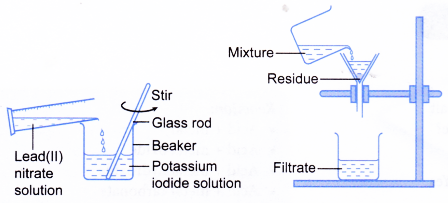
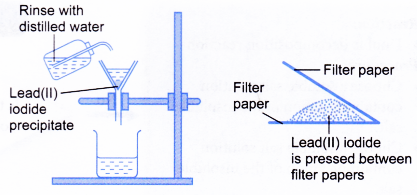
- About 20 cm3 of 0.5 mol dm-3 lead(II) nitrate solution is measured into a beaker.
- About 20 cm3 of 0.5 mol dm-3 potassium iodide solution is measured and mixed with the solution in the beaker. The mixture is stirred with a glass rod.
- The precipitate formed is removed by filtration. The precipitate is then washed with distilled water and dried by pressing it between sheets of filter paper.
B. To prepare lead(II) chromate(VI)
- About 20 cm3 of 0.5 mol dm-3 lead(ll) nitrate solution is measured into a beaker.
- About 20 cm3 of 0.5 mol dm-3 potassium chromate(VI) solution is measured and mixed with the solution in the beaker. The mixture is stirred with a glass rod.
- The precipitate formed is filtered out, washed with distilled water and dried by pressing it between sheets of filter paper.
C. To prepare barium sulphate
- About 20 cm3 of 0.5 mol dm-3 barium nitrate solution is measured into a beaker.
- About 20 cm3 of 0.5 mol dm-3 sodium sulphate solution is measured and mixed with the solution in the beaker. The mixture is stirred with a glass rod.
- The precipitate formed is filtered out, washed with distilled water and dried by pressing it between sheets of filter paper.
Observations:
- Lead(II) iodide is a yellow insoluble solid.
- Lead(II) chromate(VI) is a yellow insoluble solid.
- Barium sulphate is a white insoluble solid.
Discussion:
